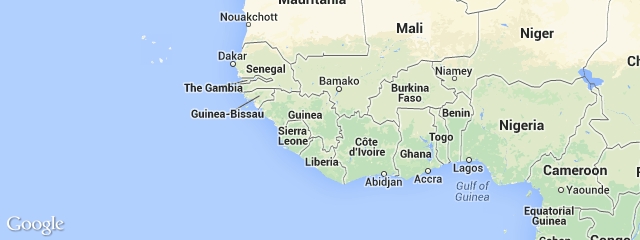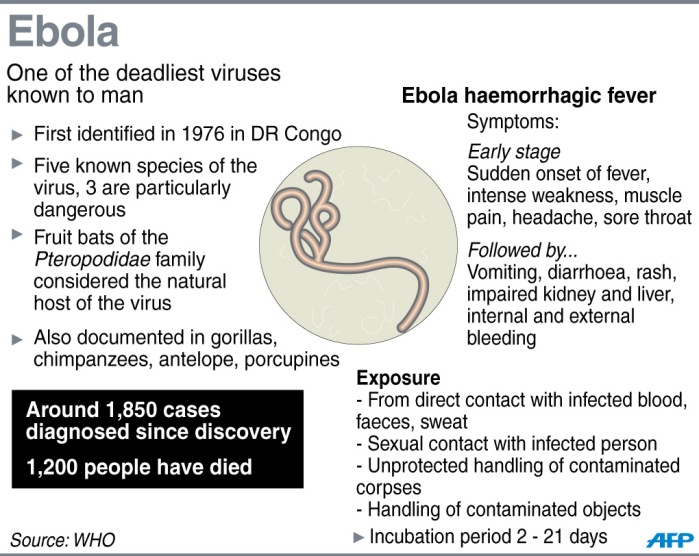Ebola virus is one of the most deadly virus known to man and the current outbreak began in February in Guinea in western Africa (see map) and you may have read that one of the noted physicians, Dr. Sheik Umar Kahn, 39 years old, who took care of these patients contracted Ebola and has died. Since the outbreak began there have been 1,093 confirmed cases with 729 deaths.
The Ebola
The major issue is that as we pull Americans out of Western Africa, will they be bringing the virus home with them?
Patrick Sawyer, a US Citizen, died in Lagos after having travelled there by plane to attend his sister’s funeral. His sister also died of Ebola.
Two Americans working in Liberia have become infected with Ebola. Dr. Kent Brantly, 33, tested positive for the virus and is being treated in Monrovia, Liveria. He has been working in Liberia since October of 2013 as the medical director for Samaritan’s Purse, a Christian relief organization.
The second American is Nancy Writebol, working with another Christian agency called Serving in Mission (SIM). She had been working to decontaminate people who entered the Monrovian Ebola Care Center.
The Peace Corps is evacuating its volunteers from Guinea, Liberia, and Sierra Leone, after two of the volunteers in Liberia came in contact with the virus.
There is no known vaccination for the virus, and the current outbreak has a death rate of over 70% of the people it has infected.
The concern now are missionaries and people coming back from this area because symptoms may not occur for several days after contracting the virus. Melissa Strickland, the spokesperson for Samaritan Purse, stated that, “Our team has followed to the letter all of the protocols for safety that were developed by the CDC (Center for Disease Control) and WHO (World Health Organization)… Obviously it is of great concern for us.. It is just an incredibly contagious disease.”

The current outbreak of Ebola has affected Western Africa
SYMPTOMS:
Onset start with symptoms like the common cold, with a sore throat, fever, and headache and then progress to abdominal pain, muscle aches, vomiting, diarrhea and ultimately bleeding eyes, more severe vomiting, and organ failure. The incubation period is anywhere from two to twenty one days. Patients are contagious as soon as they develop the fevers and headaches.
TRANSMISSION:
Close contact with bodily secretions, including blood, feces, semen, and people who come in contact with soiled clothing or bed linen.
But you saw, some who became infected were taking all the precautions that CDC recommended.
BRINGING THEM HOME:
The concern comes from bringing back Peace Corps members, missionaries, and other citizens coming home.

Will they be coming home on a commercial airliner?
Will they be in quarantine in Africa before coming home?
Will they be in a quarantine in the United States?
Why are those key questions? Because if they are infected, they could infect people on the commercial airline- leading to a much wider pandemic of one of the deadliest virus known to man.
If the come home and are quarantined – where will they stay? How will you decontaminate the area if they have been found to be infected with Ebola? What hospital facilities will they go to ?
We may be bringing home the most deadly virus known to man.
Note: besides being a physician – Dr. Simpson spent several years working at a virus laboratory with some of the world’s most deadliest viruses.
UPDATE:
Ebola is out of control and the lead organization fighting Ebola in Liberia notes that the situation has become too dangerous – the disease is spreading, and so is civil unrest. Nigerian officials are tracking 59 people who have had contact with Patrick Sawyer, who went through two airports before dying from the virus.
There are 84 flights a week leaving the affected countries that fly into cities that have direct connections to the US.
Hospitals are preparing for the possibility of Ebola virus. In Boston, hospitals are reminding staff to ask patients about travel histories and takinga bout the nature of the symptoms.
A vaccine is two to three years away- although one of the companies, Galveston National Laboratory in Texas, are ready to test them on humans have just received a 28 million grant from the National Institute of Health. They have three promising vaccines, and one of 15 facilities that are allowed to store and experiment with Ebola.
